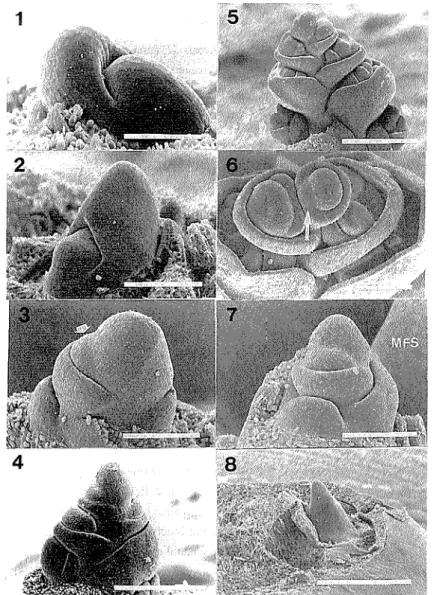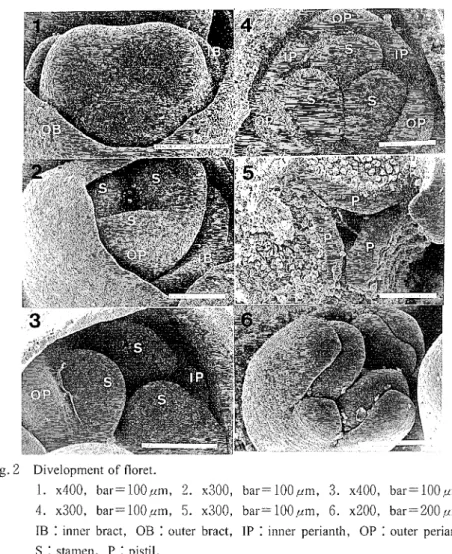Tech. Bull. Fac. Agr.. Kagawa Univ., Vo1..50, No. 2, 69-72, 1998
FLORAL INITIATION AND DEVELOPMENT IN FREESIA
Seiichi FUKAI
and Masanori
Go1Summary
Morphological changes in the shoot apex of freesia ( ~ r e e s l a
hybrids)
during floral initiation and development were determined by using a scanning electron microscope (SEM). Floral initiation was shown to occur1 in the axillary bud. The shoot apex continued to produce leaves and axillary buds with each axillaxy bud developing into a floret, resulting in inflo~escence formation The swollen apex of the axillrary bud differentiated in succession into outer perianthes, stamens, inner perianthes and pistilKey Words
:
shoot apex, freesia, flower bud..Introduction
Iridaceae plants show a unique sequence of events during floral development, e. g. floret primodium initiates outer perianthes and stamens first, then inner perianthes appearo'. This reversed sequence is not observed in other bulbous plants in Liliaceae and Amaryllidaceae. Kosugi (1953) reported the process of flower bud initiation and development in Freesla refracta var. alba in his hand s k e t ~ h ' ~ ' . However the morphological changes in shoot apex during floral initiation and development in freesia have not been described in detail The aim of this work is to determine the morphological chages in shoot apex dur'lng floral initiation and development in freesia by using a scanning electron microscope (SEM)
.
Materials and Methods
Bulbs of freesia (Freesla hybrlda cv. Rijnveld's Golden Yellow) were planted in plastic trays filled with soil on the 29th September. The trays were placed in a field. Samples were collected at 7 days interval until 8th December. Collected samples were immediately fixed with FAA (formalin: acetic acid: 70% enthanol, 5:5:90). Following fixation, leaves and bracts were removed from the shoot apex under binoculars. The specimens were then dehydrated in ethanol-acetone series and dried in a critical point dryer. After coating with Pt, the specimens were observed with SEM (Hitachi, S-2150)
.
Results and Discussion
Floral initiation and inflorescence developmentThe shoot apex was vegetative at the end of' September. The vegetative shoot apex had a leaf primordium and an apical dome (Fig..
1-11.
The size of'the dome was less than 100 um. The base of the leaf' primordium surrounded the apical dome (Fig. 1-2). Floral initiation was observed on the 3rd of' November.. The first sign of' floral initiation was the swelling of' an axillary bud (Fig. 1-3), while the7 0 Tech. Bull. Fac. Agr. Kagawa Univ., Vo1.50, No. 2 , 1998
axillary buds at lower positions showed to be thin and sharp-pointed in shape. The shape of the leaf was also different from that in the vegetative shoot apex. The leaf did not surround the apical dome and did not grow upward, resulting in a cup shape. The leaf grew as an outer bract covering the floret later on. The shoot apex produced leaves and axillary buds in succession, and each axillary bud developed into a floret, resulting in inflorecence formation (Fig. 1-4,5). Finally the shoot apex became small and stopped producing axillary buds (Fig.
1-6)
in the first week of December.Fig.
I
Floral initiation and inflorescence development.1.
Vegetative apex, x400, bar=lOO,um, 2. Vegetative apex, x200, bar=200jltn,3.
Floral initiation, Arrow indicates floret primodium, x200, bar=200,um,4. Inflorescence formation, x100, bar=500,um,
5.
Inflorescence formation, Arows indicate banches, x80, bar=500,um,6.
Top part of the inflorersce, Arrow indicates the trace of shoot apex, x200, b a r = 1 5 0 p m ,7.
Branch, MFS:
main flower stalk, x200, bar=200,um,8.
Axillary bud on the top of the new corm, x50, bar=lmm.S. FUKAI et al.
:
Floral initiation in Freesia 7 1 Two or three axillary buds below the first florets developed branches (Fig. 1-5). The first and second axillary buds on the branch were vegetative and dormant. The third axillary bud developed into a floret (Fig.1-7).
The same sequence of events as occured with the main flower stalk was observed in each branch. During the later stage of the developement of inflorescence, the stem tissues at lower positions started swelling, forming a new corm. The top axillary bud of the new corm -a new shoot for next season- had already started vegetative growth (Fig. 1-8).Developnlent of the floret
The swollen apex of the axillary bud (floret primordium) became rounded and triangular in shape (Fig. 2-1). The first leaf of the axillary bud appeared at the bottom of the floret primodium, developing into an inner bract. On the top of the floret primodium, three outer perianthes and three stamens primordia developed in the same direction and appeared at same time (Fig. 2-21. Primordia of the inner perianthes appeared after the development of stamens (Fig. 2-3) as observed in other Iridaceae Three pistil primordia appeared on the inside of stamens (Fig. 2-4) and the center of pistils caved in (Fig. 2-5). Perianthes and stamens grew upward (Fig. 2-61, with perianthes finally covering the stamens.
Fig. 2 Divelopment of floret.
1. x400, bar=100pm,
2. x300, bar=100,um,
3.
x400, bar=lOO,um,4.
x300, bar= 100,um,5.
x300, bar=10OPm, 6. x200, bar=200 ,urn. IB:
inner bract, OB:
outer bract, IP:
inner perianth, OP:
outer perianth,S
:
stamen. P:
pistil.Tech.. Bull. Fac.. Agr. Kagawa Univ., Vol. 50, No. 2 , 1998
Literature Cited
(1) BEYER, .I, .J. 1942.. De terminologie van de in Iridaceous flowers.. .I.. .Japan. Soc.. Hort. Sci.. bloemaanleg der bloembolgewassen . Labort.. 64 (SUPPL. 1)
:
506-507. (in Japanese)Bloembollenond.. 68 1 3
-
16. (4) TOMIIA, H.. and UEMATSU, 1. 1981.. Studies on the (2) Kosu~r, K.. 1953. Studies on the flower bud flowering in Iris ensata Thunb.. var, ensata. I. differentiation and development in the Freesia.. .J. Flower bud defferentiation. Bull. Saitama Hortic.. Japan.. Sco.. Hort.. Sci.. 22 1 61-63.. (in .Japanese) Exp. Stn. 10:.
29-34.. (in .Japanese with Engish (3) h u c m , K. , FIJIME, F. and HASEGAWA, A,. 1995. summary)MicromophologicaI observation of perianth initiation
(Received May

